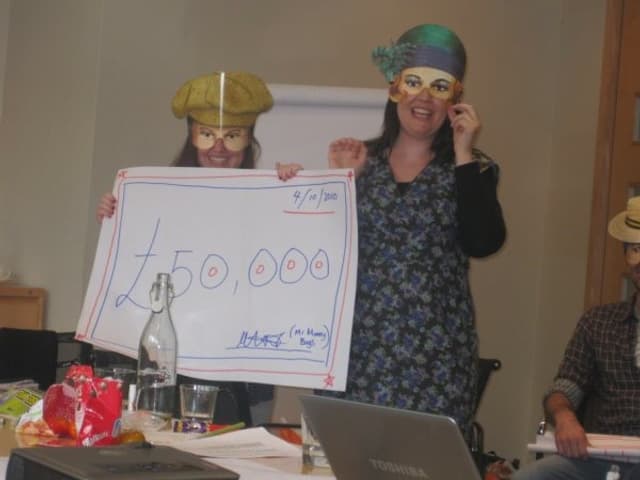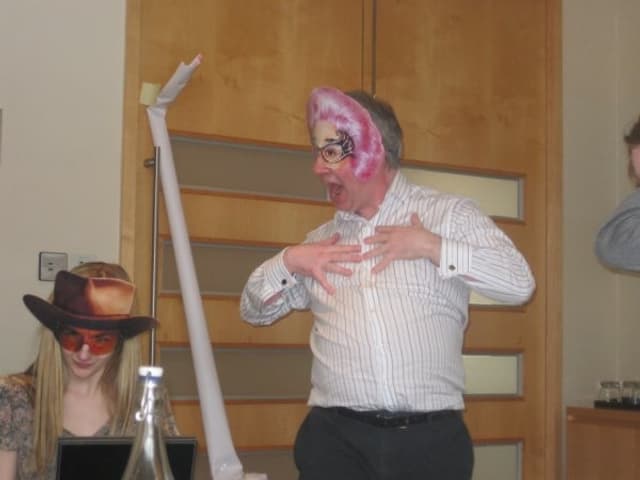Eleven tips to run a really good creative ideas session
With a little effort and planning you can ensure that your creative sessions are truly inspirational. I’ve run a lot of ideas sessions, some good and, frankly, some not so good. So to help you and to stop you making the same mistakes I made when I started, I put together the following simple rules:
- Written by
- Lucy Gower
- Added
- May 23, 2013
1. Focus

Be really clear on what the session is for and what you want to achieve. Ensure that participants know what the aims of the session are. You must have a focus that is broad enough for people to have room to be creative, but tight enough that you will get ideas that are relevant. For example, don’t ask people ‘How can we raise more money?’ it’s too broad. Focus will help you get ideas that you are more likely to be able to put into action. It helps people to have a focus. Think about what area of your fundraising will make the most impact on your current activities and focus people’s energy on that – for example could it be, ‘How do we raise £5 more per month from our regular donors?’
2. Have an independent facilitator
A facilitator is responsible for directing discussion, makes sure the session runs on time and gets the best from everyone in the room. Remember not everyone is extroverted and happy to put her or his ideas on the line. A good facilitator will ensure that everyone in the room gets heard, including the more reserved people, and that a range of techniques to provoke creative thinking techniques are used. Ensure your facilitator is impartial and doesn’t have her own agenda. How often has an ideas session been a smokescreen to legitimise the session organiser’s idea?
3. Get a mix of people in the room
The more diverse the group of people in the room, the more likely you are to get a range of different perspectives on your topic. Invite people from different teams: people in direct contact with donors, service staff, reception staff, the finance team, who swear they are not creative but, in my experience, invariably bring great insights. Can you involve your volunteers and service users?

It is crucial that you set some rules and that everyone in the session agrees to them. My suggested list is:
- Listen to each other’s ideas and build on them – that’s why you have different people, with different perspectives, in the room, great ideas are often combinations of several ideas.
- Respect each other’s opinions.
- No hierarchy – everyone is equal.
- Quantity – it’s about lots of ideas. The first part of the session is about as many new starting points as possible, no matter how crazy they sound – refer to point one.
- No idea killers – for example, ‘We’ve done it before, it didn’t work’; ‘we don’t have a budget’; we won’t get it signed off’. None of these destroyers of creativity are allowed. In fact have a forfeit for anyone who does kill an idea. It’s human nature to try and help by pointing out where things haven’t worked in the past, but the world moves fast – what didn’t work before might work now, or it might work if delivered differently. More importantly killing an idea, however helpfully, stops people taking part; we all fear criticism and once someone has killed your idea you become less likely to put your neck on the line again.
- Have fun – creating a playful atmosphere and having a sense of fun will help your creativity. It’s a legitimate part of the idea generating process so embrace it. If you’re organising the session it’s your responsibility to provide and encourage this.

Have you ever had your best idea sitting behind your desk? Most likely not. So try to find somewhere away from the office where people feel relaxed, for example, a corporate partner’s offices, local café, or the park. If you can’t leave the building do what you can to make the environment you have as relaxed as possible with food, toys, music, any props that relate to the subject matter. So if you are thinking up fundraising ideas for Christmas get the Santa hats and tinsel out. Also consider the time of day, at four in the afternoon you won’t get the best out of people. Try for early morning before people have a chance to check their emails.
6. A creative session is always in two parts
Part 1 - diverge
This is about getting lots and lots of ideas, nothing should be filtered here, anything goes. I’m not saying any idea is a good idea, but this part of the session is about describing all the ideas, no matter how crazy they sound, somewhere there may be a gem of brilliance. A while ago, conventional wisdom thought the idea to wear a rubber band on your wrist that you bought for a $1 was a rubbish idea. NIKE produced over 5,000, initially for Livestrong; ultimately over 70 million wristbands in different colours were produced for a range of charities and raised a huge amount of money. Thank goodness that idea didn’t get killed in its initial stages. Build on each other’s ideas, find your inner child and have fun with it. It really is OK to have fun at work by the way.
Part 2 - converge
This is where we select the ideas that have some potential; the ones that fulfil the brief and can be developed and piloted. How you choose the best ideas will depend on your initial focus. You might prioritise the idea that will have the most impact, or is easiest to deliver, or the most simple. Choose several and work them all into brief business plans. Then you should filter the best ideas, the ones that you really think have the potential to work into a more in-depth business plan. This won’t be at the creative session. For instance, if your idea is for a new event for high value individuals you should involve staff from that team when making that business plan. The level of detail for a business plan is for after the creative session.
7. Use creative thinking techniques
Plan and structure your session with your independent facilitator. If you genuinely want fresh ideas you have to help people approach the challenge from a new perspective. There are many tools and techniques for fresh thinking. Check out the resource section below and top 10 techniques for fresh thinking for more information. Use at least two different techniques, this way you will have more chance to appeal to more people’s creative preferences. Fight the temptation to stop at your first good idea. Often the first good idea is OK – but who wants to settle for OK? Keep generating more ideas after your OK idea – you will be surprised at what you get.
8. Look after your participants
We’ve all been there, got all fired up at an ideas session and then not heard about it again. You wonder whatever happened to all the energy in the room. Did the ideas ever come to anything?
Treat the people who give up their time to attend your ideas session as your closest allies, give them a great experience and look after them well. Thank them for showing up with their ideas, give them an opportunity to keep in contact after the session. Some people mull things over and have their ‘aha’ moment after the event, so ensure they know that they can still have input after the session. If an idea from the session gets implemented, let everyone know. If nothing happens, let them know that too.
9. Plan
Allow enough time to plan your creative session, think about who you invite, the creative thinking techniques you are going to use, which ones are most suited to your audience and the challenge. Allow enough time, find a venue, ensure you have the capacity to follow up, provide refreshments. Think about how you can make it an inspiring experience for the participants. Make them want to come back again.
10. Enjoy the ride
Have fun, lighten up – humour and a sense of play are important catalysts for innovative thinking. Playing music during activities and putting toys on the tables helps to create an atmosphere of play.
11. Manage your expectations
Your creative session cannot be the answer to all your problems. But it will provide a great start to getting to grips with many of them. Initially, there’s no guarantee that you are going to come up with the next big fundraising idea, even if you follow all the above guidelines. But if you don’t try you definitely won’t come up with anything new. So give it a go – what’s the worst that can happen?
Have a go and let me know how you get on.
















